- Competitive Exams
- Maharashtra State Board
- Guest Corner
- News & Events
- Magazines & Journals
- News & Events
- GR & Circulars
- Important Links
- Privacy Policy


Information Transfer: Verbal-Non Verbal

1. Write a paragraph on “Rocks and Their Formations”, with the help of following Table:
2. Read the following tree-diagram and write a short paragraph based on it:
3. Read the following web diagram and write a short paragraph based on it:
1. Read the given information carefully and fill the Table provided:
2. Read the following information about ‘Mind-map’ and draw a Web diagram regarding the facts about ‘Mind-map’:
3. Read the following information about ‘Importance of Books’ and draw a Web diagram regarding the facts about it:
More examples will be added very soon… Keep visiting the page regularly…

RELATED ARTICLES MORE FROM AUTHOR

Top 100 Commonly Confused Word Pairs in English

English Grammar: Singular and Plural Nouns

LEAVE A REPLY Cancel reply
Save my name, email, and website in this browser for the next time I comment.
Recent Post

How to Close a Speech

20 Ways to Say ‘No’

Code-mixing and Code-switching

English in France: The Rising Influence of a Global Language

English Language in Canada: A Linguistic Mosaic of Diversity and Inclusivity

The Evolution and Significance of the English Language in Australia

The English Language in Singapore: A Linguistic Mosaic of Diversity and...
Even more news.

POPULAR CATEGORY
- Speaking 17
- News & Events 7
TheEnglishGrammars
By Mahesh Prajapati

Verbal to Non-verbal | Information Transfer | Writing Skills
Here you will learn how to transfer the given information in non-verbal form vis table. pie diagram, web diagram, flow chart and tree diagram etc.
Q. 1. Given below is a paragraph outlining the uses of motorcycle. Transfer the information in the form of a web diagram or map.
The motorcycle has become a vehicle that has many uses not only in the town but in the countryside as well. For one thing it saves a lot of time. Even in towns and villages it is very useful for college students who have to travel long distances instead of depending on the irregular bus services. There are many people in towns and cities who keep motorcycles for their servants to go out and buy provisions. Workers in cities and even farmers in villages use the motorcycle frequently. This is because the motorcycle helps to get the work done speedily. Of course, in order to drive the motorcycle a driving licence is compulsory. Also one must use a helmet and drive carefully to avoid serious accident.
Ans: The Uses of Motorcycle
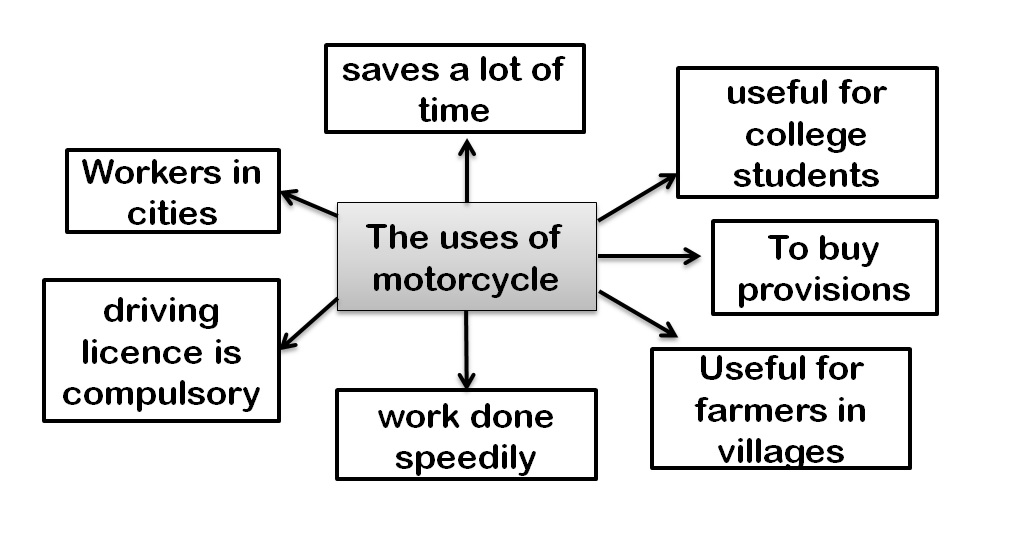
Click here for Non-verbal to Verbal
Q.2. Read the following information and prepare a table to present it.
According to survey the youth preferences for watching TV, it was found that 39% of the youth watch TV for news while 18% watches serials. Sports seems to be the choice of 10% while movies in the preference of 7% youth.
The lowest preference seems to be music channels as only 6% watch them the remaining 20% used did not seem to have any specific reference.
Ans.: Youth and TV
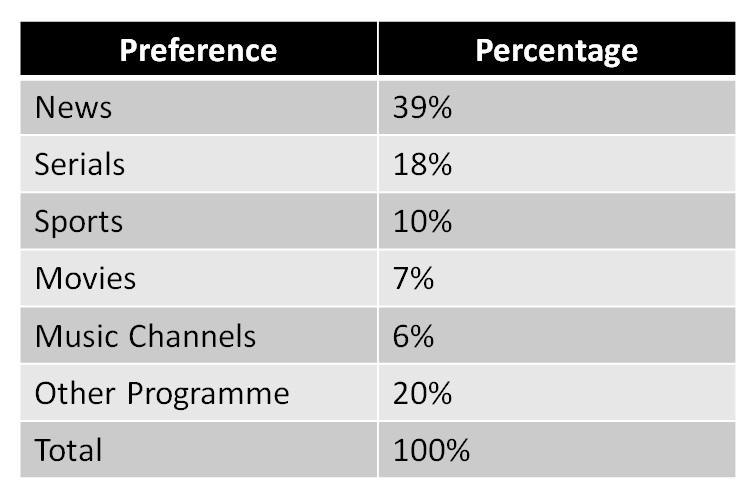
Click here for Letter Writing
Q.3. Draw a pie diagram for the following data.
Mr. A. Phalke earns a take-home salary of Rs. 11,200 per month. He follows a strict budget every month on various expenditures, as a result of which he is able to save as much as 7% of his income per month. Most of his income which accounts for 30% of his total budget is spent on conveyance. 10% of his income goes towards the food and fuel needs for needs of his family. Mr. Phalke hires a housemaid and pays her about 10% of his earnings. Every month at least 17% of his income goes towards buying clothing for various members of family. The remaining 26% is spent on the education of his children.
Ans.: Expenditure of Mr. A. Phalke

Click here for Do’s and Don’ts
- ← Letter Writing | Formal Letter | Writing Skills
- View and Counterview | Writing Skills | Mahesh Prajapati →
You May Also Like

Dialogue Writing |Mahesh Prajapati |English Grammar

Dialogue Writing | Writing Skills | Mahesh Prajapati

Writing Skills | Information Transfer | Mahesh Prajapati
Leave a reply cancel reply.
Your email address will not be published. Required fields are marked *
Save my name, email, and website in this browser for the next time I comment.
- Undergraduate
- High School
- Architecture
- American History
- Asian History
- Antique Literature
- American Literature
- Asian Literature
- Classic English Literature
- World Literature
- Creative Writing
- Linguistics
- Criminal Justice
- Legal Issues
- Anthropology
- Archaeology
- Political Science
- World Affairs
- African-American Studies
- East European Studies
- Latin-American Studies
- Native-American Studies
- West European Studies
- Family and Consumer Science
- Social Issues
- Women and Gender Studies
- Social Work
- Natural Sciences
- Pharmacology
- Earth science
- Agriculture
- Agricultural Studies
- Computer Science
- IT Management
- Mathematics
- Investments
- Engineering and Technology
- Engineering
- Aeronautics
- Medicine and Health
- Alternative Medicine
- Communications and Media
- Advertising
- Communication Strategies
- Public Relations
- Educational Theories
- Teacher's Career
- Chicago/Turabian
- Company Analysis
- Education Theories
- Shakespeare
- Canadian Studies
- Food Safety
- Relation of Global Warming and Extreme Weather Condition
- Movie Review
- Admission Essay
- Annotated Bibliography
- Application Essay
- Article Critique
- Article Review
- Article Writing
- Book Review
- Business Plan
- Business Proposal
- Capstone Project
- Cover Letter
- Creative Essay
- Dissertation
- Dissertation - Abstract
- Dissertation - Conclusion
- Dissertation - Discussion
- Dissertation - Hypothesis
- Dissertation - Introduction
- Dissertation - Literature
- Dissertation - Methodology
- Dissertation - Results
- GCSE Coursework
- Grant Proposal
- Marketing Plan
- Multiple Choice Quiz
- Personal Statement
- Power Point Presentation
- Power Point Presentation With Speaker Notes
- Questionnaire
- Reaction Paper
Research Paper
- Research Proposal
- SWOT analysis
- Thesis Paper
- Online Quiz
- Literature Review
- Movie Analysis
- Statistics problem
- Math Problem
- All papers examples
- How It Works
- Money Back Policy
- Terms of Use
- Privacy Policy
- We Are Hiring
Verbal and Nonverbal Communication, Essay Example
Pages: 2
Words: 575
Hire a Writer for Custom Essay
Use 10% Off Discount: "custom10" in 1 Click 👇
You are free to use it as an inspiration or a source for your own work.
Through long years of development, humanity has worked out the combined system of communication, that enables people to interact and transfer information either through verbal or nonverbal way.
Verbal communication founds on the use of language, which is defined by prominent linguist Sapir as “purely human and non-instinctive method of communicating ideas, emotions, and desires by means of a system of voluntarily produced symbols” (Sapir,2007, p.17).
Evidently, spoken language remains the most wide-spread and universal way of rendering information. Therefore, it is the most examined method of language; each road sign conveys specific meaning (“roadwork” or “overtaking prohibited”). Words in their entity serve the chief elements of communication. All the signs accepted in society may be translated by means of communication; their precise meaning becomes clear through the system of verbal and nonverbal devices. The latter affirm, doubt, and justify what is said. The speaker shows ironic or sarcastic attitude to the word by corresponding intonation solely.
Nonverbal communication plays a significant part in information exchange and provides effective personal self-expression because most part of information man receives through the visual channel. Researchers identify kinesics (messages sent by the body and face), paralanguage (voice characteristics: pitch, volume, pace), chronemics (connected with status and punctuality), proxemics (distance between communicators), olfactics (acceptable or unacceptable scents).
Nonverbal codes are considered more reliable and honest in comparison with verbal means because of their less conscious and controlled character.
There are similar expressive movements for different cultures. According to Hindle, “one of the expressions people of different cultures may produce when angry is characterized by opening the corners of the mouth in a particular way and by frowning…, clenching the fists, stamping on the ground and even hitting at objects” (Hindle,1972, p. 299).
Cultural differences in communication codes are object of study for many modern researches. Albert Mehrabian claims that first attempts to identify “the differences encountered during an interaction between members of different cultures” were done by Hall in 1959 (Mehrabian, 2009, p. 6).
One gesture may have different meanings in different cultures. Nodding for “yes” in most countries means “no” in Bulgaria; and vice versa for “not”. Acceptable in one culture may be supposed offensive in another. Indians break bread with right hand solely because the left hand is connected with toilet functions.
Interpersonal space plays a significant part of the process of communication. The attitude of the addressee towards the speaker changes if the comfortable distance is broken. Scientists pay attention to gender related traditions in various countries. In Islamic and Asian cultures touch to the opposite gender person may be considered offend or sexual infringement; in European culture touch of close friends is an ordinary expressive gesture. Shaking hands, men greet each other; this gesture is not adopted among women.
In the process of communication, people belonging to one ethnicity or social group create believes, myths, values. Thus, words bear cultural information revealing distinctions in the spoken language, as well. Ignorance of relevant nuances hampers from understanding a foreign culture. As a rule, notions of this kind are translated through explanation (national heroes, holidays, dishes, historical events etc). Thus, words are not only the signs which identify notions.
The unity of verbal and nonverbal devices enables effective communication. Learning major accepted and forbidden things of the culture you are going to interact with may be helpful to avoid misunderstanding.
Hindle, R. A. (1972). Non-verbal Communication. Cambridge: Cambridge University Press.
Mehrabian, A. (2009). Nonverbal Communication. New Jersey: Aldine Transaction.
Sapir, E.(2007). Language: an Introduction into the Study of Speech. BiblioBazaar.
Stuck with your Essay?
Get in touch with one of our experts for instant help!
Disablities In Composers, Term Paper Example
Loss, Grief & Separation, Research Paper Example
Time is precious
don’t waste it!
Plagiarism-free guarantee
Privacy guarantee
Secure checkout
Money back guarantee

Related Essay Samples & Examples
Voting as a civic responsibility, essay example.
Pages: 1
Words: 287
Utilitarianism and Its Applications, Essay Example
Words: 356
The Age-Related Changes of the Older Person, Essay Example
Words: 448
The Problems ESOL Teachers Face, Essay Example
Pages: 8
Words: 2293
Should English Be the Primary Language? Essay Example
Pages: 4
Words: 999
The Term “Social Construction of Reality”, Essay Example
Words: 371
Comparison of Verbal and Nonverbal Communication
Communication is an instrumental tool which facilitates effective interaction among individuals. Although it is vital in improving interpersonal relationships, most people take it for granted and fail to enhance their communication skills. It can be either verbal or nonverbal, and the type used to exchange information or ideas is influenced by various factors, including the parties involved as well as the environment. Verbal communication involves the conveyance of a message using oral or written words. Conversely, nonverbal communication uses body language to send a particular message. While verbal and nonverbal communications involve transferring and receiving information and are not connected to the brain, they are significantly different in such features as structure, miscommunication, continuousness, and distance and time.
Verbal communication develops differently in various cultures and is structured while nonverbal communication is not. Verbal communication is regulated by grammar rules to ensure that the conveyed message is clear (Wahyuni 80). This aspect of specific pattern of communication is vital since it guarantees a similar understanding of a particular message among the individuals using the same language. Conversely, nonverbal communication lacks a definite array of conveying a message. It has no guiding rules, and one can interpret the sent information according to their wish. Nevertheless, nonverbal communication has an instrumental role in supporting verbal communication to enhance meaning of sent information.
The chances of miscommunication in verbal communications are significantly lower than in nonverbal communication. Notably, every word used in verbal communication has a specific meaning, minimizing the possibility of being misinterpreted. The intended message significance is preserved even when words are translated into other languages. Conversely, there are numerous facial expressions which people can make using muscles in their faces. The lexes depend on how someone responds to a particular stimulus. Additionally, there are types of nonverbal communications whose meaning varies from one culture to another (Wahyuni 82). For instance, avoiding direct eye contact when speaking to an older person is a sign of respect in some cultures, but it can be interpreted as a person being shy. Therefore, the likelihoods of misinterpreting nonverbal communication are high, mainly when cultural background differs.
The chances of miscommunication depending on situations and places are also lower in verbal communication than in nonverbal communication. Whereas one receives immediate feedback when using verbal communication, it is impossible in nonverbal communication because it takes some time to show the emotions (Wahyuni 82). Indeed, an individual has to process the meaning of a message conveyed verbally before responding nonverbally. The tone of verbal communication minimizes the possibility of miscommunication in different situations, even when someone is playacting. However, miscommunication can be inevitable in various places, such as Asia and the United States because of varying cultures. Nevertheless, misunderstanding of nonverbal communication does not occur in all situations. Thus, verbal communication is easily influenced by social as well as cultural factors.
Distance is insignificant in verbal communication, and it takes a short period of time to convey a message, contrary to nonverbal communication. People use different means of sending information such as phone calls, letters, and chats to transmit messages. The distance does not matter even though one has to choose the medium wisely to guarantee effective communication. However, long-distance inhibits nonverbal communication, requiring individuals’ face-to-face interaction to show and receive a particular message. Additionally, it is time consuming compared to verbal communication. One can take time to receive and interpret nonverbal messages before giving appropriate feedback. Therefore, verbal communication is faster, efficient, and convenient regardless of location of involved parties.
Contrary to nonverbal communication, verbal communication has limited continuousness because it is easier for someone to interrupt. It has a starting point when one initiates communication and stops when it is terminated or interrupted. Different factors such as sound and visible movements can interrupt verbal communication. On the other hand, nonverbal communication continues without inference once it is initiated. Nonverbal cues are evident even when individuals have stopped talking. For instance, people smile or laugh after they comment on something good. Therefore, nonverbal communication can endure external elements that interfere with transmission of information.
Despite the differences between nonverbal and verbal communication, their role and usage consistency are similar. Both forms of communication involve sending and receiving messages, regardless of the medium used to transmit information. In most cases, individuals use verbal and nonverbal communication in parallel to guarantee the useful meaning of the anticipated outcomes (Bhat and Kingsley 39). Nonverbal communication has various functions such as reinforcement, regulation, accentuation, and substitution. Moreover, both verbal and nonverbal communication are not inherent because they are learned. People learn how to pronounce words, write well-structured sentences, and use their faces and other parts of the body to convey a meaningful message. Further, they have no direct connection to the brain of individuals. Undeniably, the brain only receives, processes and interprets messages, and generates appropriate feedback. Thus, verbal and nonverbal communications complement each other to enhance the meaning of conveyed messages.
In conclusion, verbal and nonverbal communication differ in structure, miscommunication, continuousness, and distance and time. Verbal communication is regulated by grammar rules, has minimum miscommunication possibilities, is not inhibited by distance, takes a short time, and is quickly interrupted, contrary to nonverbal communication. However, common features associated with verbal and nonverbal communication are that they are not inherent or directly connected to individual’s brain and involve transferring and receiving of information. Additionally, they are used in parallel in most cases, with nonverbal playing the role of reinforcement or accentuation of particular message.
Works Cited
Bhat, B. Vishnu, and Manoj Kumar Kingsley. “Effective Non-Verbal Communication.” Effective Medical Communication , edited by Subhash Chandra Parija and Balachandra V. Adkoli, Springer, 2020, pp. 39–47.
Wahyuni, Akhtim. “The Power of Verbal and Nonverbal Communication in Learning”. Proceedings of the 1St International Conference on Intellectuals’ Global Responsibility (ICIGR 2017) , vol. 125, 2018, pp. 80-83. Web.
Cite this paper
- Chicago (N-B)
- Chicago (A-D)
StudyCorgi. (2022, June 9). Comparison of Verbal and Nonverbal Communication. https://studycorgi.com/verbal-vs-nonverbal-communication/
"Comparison of Verbal and Nonverbal Communication." StudyCorgi , 9 June 2022, studycorgi.com/verbal-vs-nonverbal-communication/.
StudyCorgi . (2022) 'Comparison of Verbal and Nonverbal Communication'. 9 June.
1. StudyCorgi . "Comparison of Verbal and Nonverbal Communication." June 9, 2022. https://studycorgi.com/verbal-vs-nonverbal-communication/.
Bibliography
StudyCorgi . "Comparison of Verbal and Nonverbal Communication." June 9, 2022. https://studycorgi.com/verbal-vs-nonverbal-communication/.
StudyCorgi . 2022. "Comparison of Verbal and Nonverbal Communication." June 9, 2022. https://studycorgi.com/verbal-vs-nonverbal-communication/.
This paper, “Comparison of Verbal and Nonverbal Communication”, was written and voluntary submitted to our free essay database by a straight-A student. Please ensure you properly reference the paper if you're using it to write your assignment.
Before publication, the StudyCorgi editorial team proofread and checked the paper to make sure it meets the highest standards in terms of grammar, punctuation, style, fact accuracy, copyright issues, and inclusive language. Last updated: November 11, 2023 .
If you are the author of this paper and no longer wish to have it published on StudyCorgi, request the removal . Please use the “ Donate your paper ” form to submit an essay.

- INTERPERSONAL SKILLS
- Communication Skills
What is Communication?
Search SkillsYouNeed:
Interpersonal Skills:
- A - Z List of Interpersonal Skills
- Interpersonal Skills Self-Assessment
- Interpersonal Communication Skills
- Tips for Effective Interpersonal Communication
- Principles of Communication
- Barriers to Effective Communication
- Avoiding Common Communication Mistakes
- Social Skills
- Getting Social Online
- Giving and Receiving Feedback
- Improving Communication
- Interview Skills
- Telephone Interviews
- Interviewing Skills
- Business Language Skills
- The Ladder of Inference
- Listening Skills
- Top Tips for Effective Listening
- The 10 Principles of Listening
- Effective Listening Skills
- Barriers to Effective Listening
- Types of Listening
- Active Listening
- Mindful Listening
- Empathic Listening
- Listening Misconceptions
- Non-Verbal Communication
- Personal Appearance
- Body Language
- Non-Verbal Communication: Face and Voice
- Verbal Communication
- Effective Speaking
- Conversational Skills
- How to Keep a Conversation Flowing
- Conversation Tips for Getting What You Want
- Giving a Speech
- Questioning Skills and Techniques
- Types of Question
- Clarification
- Emotional Intelligence
- Conflict Resolution and Mediation Skills
- Customer Service Skills
- Team-Working, Groups and Meetings
- Decision-Making and Problem-Solving
- Negotiation and Persuasion Skills
- Personal and Romantic Relationship Skills
The SkillsYouNeed Guide to Interpersonal Skills

Subscribe to our FREE newsletter and start improving your life in just 5 minutes a day.
You'll get our 5 free 'One Minute Life Skills' and our weekly newsletter.
We'll never share your email address and you can unsubscribe at any time.
Communication is simply the act of transferring information from one place, person or group to another.
Every communication involves (at least) one sender, a message and a recipient. This may sound simple, but communication is actually a very complex subject.
The transmission of the message from sender to recipient can be affected by a huge range of things. These include our emotions, the cultural situation, the medium used to communicate, and even our location. The complexity is why good communication skills are considered so desirable by employers around the world: accurate, effective and unambiguous communication is actually extremely hard.
This page explains more about what we mean by ‘ communication ’.
Defining Communication
communication , n . The imparting or exchanging of information by speaking, writing, or using some other medium. …The successful conveying or sharing of ideas and feelings.
Oxford English Dictionary
As this definition makes clear, communication is more than simply the transmission of information. The term requires an element of success in transmitting or imparting a message, whether information, ideas, or emotions.
A communication therefore has three parts: the sender, the message, and the recipient.
The sender ‘encodes’ the message, usually in a mixture of words and non-verbal communication. It is transmitted in some way (for example, in speech or writing), and the recipient ‘decodes’ it.
Of course, there may be more than one recipient, and the complexity of communication means that each one may receive a slightly different message. Two people may read very different things into the choice of words and/or body language. It is also possible that neither of them will have quite the same understanding as the sender.
In face-to-face communication, the roles of the sender and recipient are not distinct. The two roles will pass back and forwards between two people talking. Both parties communicate with each other, even if in very subtle ways such as through eye-contact (or lack of) and general body language. In written communication, however, the sender and recipient are more distinct.
Categories of Communication
There are a wide range of ways in which we communicate and more than one may be occurring at any given time.
The different categories of communication include:
Spoken or Verbal Communication , which includes face-to-face, telephone, radio or television and other media.
Non-Verbal Communication , covering body language, gestures, how we dress or act, where we stand, and even our scent. There are many subtle ways that we communicate (perhaps even unintentionally) with others. For example, the tone of voice can give clues to mood or emotional state, whilst hand signals or gestures can add to a spoken message.
Written Communication : which includes letters, e-mails, social media, books, magazines, the Internet and other media. Until recent times, a relatively small number of writers and publishers were very powerful when it came to communicating the written word. Today, we can all write and publish our ideas online, which has led to an explosion of information and communication possibilities.
Visualizations : graphs and charts , maps, logos and other visualizations can all communicate messages.
The desired outcome or goal of any communication process is mutual understanding.
The Communication Process
A message or communication is sent by the sender through a communication channel to a receiver, or to multiple receivers.
The sender must encode the message (the information being conveyed) into a form that is appropriate to the communication channel, and the receiver(s) then decodes the message to understand its meaning and significance.
Misunderstanding can occur at any stage of the communication process.
Effective communication involves minimising potential misunderstanding and overcoming any barriers to communication at each stage in the communication process.
See our page: Barriers to Effective Communication for more information.
An effective communicator understands their audience , chooses an appropriate communication channel, hones their message to this channel and encodes the message to reduce misunderstanding by the receiver(s).
They will also seek out feedback from the receiver(s) as to how the message is understood and attempt to correct any misunderstanding or confusion as soon as possible.
Receivers can use techniques such as Clarification and Reflection as effective ways to ensure that the message sent has been understood correctly.
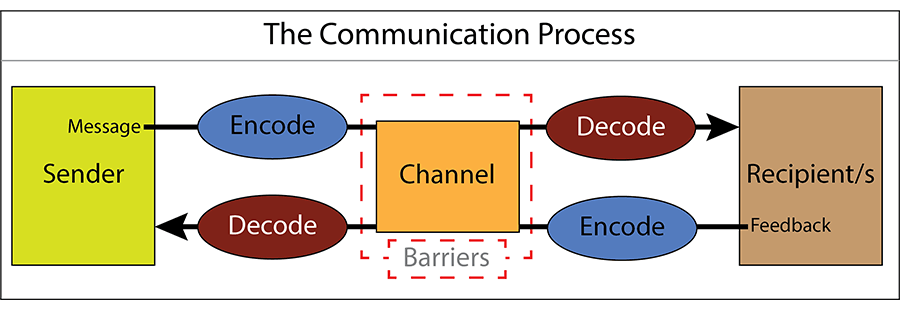
Communication Channels
Communication channels is the term given to the way in which we communicate. It is therefore the method used to transmit our message to a recipient, or to receive a message from someone else.
There are multiple communication channels available to us today. These include face-to-face conversations, telephone calls, text messages, email, the Internet (including social media such as Facebook and Twitter), radio and TV, written letters, brochures and reports.
Choosing an appropriate communication channel is vital for effective communication. Each communication channel has different strengths and weaknesses.
For example, broadcasting news of an upcoming event via a written letter might convey the message clearly to one or two individuals. It will not, however, be a time- or cost-effective way to broadcast the message to a large number of people. On the other hand, conveying complex, technical information is easier via a printed document than a spoken message. The recipients are able to assimilate the information at their own pace and revisit anything that they do not fully understand.
Written communication is also useful as a way of recording what has been said, for example by taking minutes in a meeting.
See our pages: Note Taking and How to Conduct a Meeting for more.
Encoding Messages
All messages must be encoded into a form that can be conveyed by the communication channel chosen for the message.
We all do this every day when transferring abstract thoughts into spoken words or a written form. However, other communication channels require different forms of encoding, e.g. text written for a report will not work well if broadcast via a radio programme, and the short, abbreviated text used in text messages would be inappropriate in a letter or in speech.
Complex data may be best communicated using a graph, chart or other visualisation.
Effective communicators encode their messages so that they fit both the channel and the intended audience. They use appropriate language, conveying the information simply and clearly. They also anticipate and eliminate likely causes of confusion and misunderstanding. They are generally aware of the recipients’ experience in decoding similar communications.
Successful encoding of messages for the audience and channel is a vital skill in effective communication.
You may find our page The Importance of Plain English helpful.
Decoding Messages
Once received, the recipient needs to decode the message. Successful decoding is also a vital communication skill.
People will decode and understand messages in different ways.
This will depend on their experience and understanding of the context of the message, how well they know the sender, their psychological state and how they feel, and the time and place of receipt. They may also be affected by any Barriers to Communication which might be present.
There are therefore a wide range of factors that will affect decoding and understanding.
Successful communicators understand how the message will be decoded, and anticipate and remove as many as possible of the potential sources of misunderstanding.
The final part of a communication is feedback: the recipient lets the sender know that they have received and understood the message.
Recipients of messages are likely to provide feedback on how they have understood the messages through both verbal and non-verbal reactions. Effective communicators pay close attention to this feedback as it is the only way to assess whether the message has been understood as intended, and it allows any confusion to be corrected.
Bear in mind that the extent and form of feedback will vary with the communication channel. Feedback during a face-to-face or telephone conversation will be immediate and direct, whilst feedback to messages conveyed via TV or radio will be indirect and may be delayed, or even conveyed through other media such as the Internet.
Effective communicators pay close attention to this feedback as it is the only way to assess whether the message has been understood as intended, and it allows any confusion to be corrected.
You can always ask!
You may be unsure if a message has been successfully received and decoded, especially if you do not get much feedback from the recipient. If so, you can always ask!
A quick question is a good start, for example:
“ Is that OK? ” or “ Are you clear about that? ”
If you want more detailed feedback or to check that the recipient has really understood, you might say something like:
“ So, let’s just run over that one more time. I think I am going to do x, and you are going to do y. Is that your understanding too? ”
More on feedback: see our pages on Reflection , Clarification and Giving and Receiving Feedback .

Further Reading from Skills You Need
Our Communication Skills eBooks
Learn more about the key communication skills you need to be an effective communicator.
Our eBooks are ideal for anyone who wants to learn about or develop their communication skills, and are full of easy-to-follow practical information and exercises.
Being able to communicate effectively is the most important of all life skills.
Understanding is the first step to improvement
Understanding more about communication and how it works is the first step to improving your communication skills. A good understanding of the process, and how it operates, will help you to become better at encoding and decoding messages.
Continue to: Principles of Communication Interpersonal Communication Skills
See also: Intercultural Communication Skills Effective Speaking Improving Communication

- school Campus Bookshelves
- menu_book Bookshelves
- perm_media Learning Objects
- login Login
- how_to_reg Request Instructor Account
- hub Instructor Commons
- Download Page (PDF)
- Download Full Book (PDF)
- Periodic Table
- Physics Constants
- Scientific Calculator
- Reference & Cite
- Tools expand_more
- Readability
selected template will load here
This action is not available.

6.1: Introduction to Nonverbal Communication
- Last updated
- Save as PDF
- Page ID 90697

- Daniel Usera & contributing authors
- Austin Community College
LEARNING OUTCOMES
- Define nonverbal communication and explain its metacommunicative nature.
- Describe the process of nonverbal communication.
- Assess the impact of nonverbal communication in interpersonal relationships.
INTRO TO NONVERBAL COMMUNICATION
Defining nonverbal communication
Your partner flashes a big smile when you surprise them for their birthday even though they secretly are embarrassed. You send an emoji “face with tears of joy” (��) to your BFF after getting a perfect score on a rhetorical criticism paper. You kiss someone on a first date. What do these scenarios have in common? Nonverbal communication of course -- an essential but frequently misunderstood dimension of interpersonal relations (Gifford, 2011). Nonverbal communication is often simply defined as communication without words. Others have noted that nonverbal communication includes “all behaviors that are not words” (Guerrero & Floyd, 2006, p. 4). Regardless of the deceiving simplicity of its definition, know that nonverbal communication is very complex.
In everyday life, nonverbal communication is multimodal and multifunctional in nature serving many functions. It is closely linked to how we feel about our relationships with others and how we manage those relationships. In interpersonal interaction, nonverbal messages can be found in facial expressions, eyes, body language, touching as well as clothing, tone of voice, posture and even spatial distance. Indeed, you can say a lot without saying anything, or as psychologist and philosopher Paul Watzlawick (1978) observed in the first axiom of his interpersonal communication theory that you cannot not communicate. The inevitability of sending and receiving messages is extremely important to understand because it means that each of us is a type of “transmitter” that cannot be shut off. Nonverbal behaviors are implicated in messages of intimacy, arousal and composure, dominance, formal, and task or social orientation. Whether intentional or unintentional, deceitful or sincere, no matter what we do, we give off information about ourselves. In short, nonverbal communication is an important part of human interaction and always present in face-to-face interactions.
A related concept is what social scientists call metacommunication -- communicating about communication. In interpersonal relationships, it involves how people perceive you, not just your words. For example, if I say, “Nice to see you!” to someone and roll my eyes at the same time, they will likely doubt my sincerity.
This example illustrates one of the more interesting effects of nonverbal messages: most people tend to believe the nonverbal message over the verbal message if the two appear to be in disagreement (Knapp, 1972; Knapp, Earnest, Griffin, & McGlone, 2020; Malandro & Barker, 1983; Mehrabian, 1981). People seem to believe that actions really do speak louder than words. As a result, they place a disproportionate emphasis on the nonverbal response -- therefore it’s always a good idea to make nonverbal behavior consistent with our verbal messages (Hackman & Johnson, 2000).
So, welcome to the world of nonverbal communication. Its types, its contexts, and its impacts -- all of these will be explored in the pages that follow.
The process of nonverbal communication
Is nonverbal communication its own type of language? Yes and no. Like language, the fundamental process of nonverbal communication consists of a message encoded in a selected medium (body language, for example) that is then decoded. When you form language and speak it, your brain encodes a thought into words and intelligible sounds. For example, if you want to tell someone to leave the room, you can simply speak the words, “Please leave the room.” Nonverbally, you can also encode an extra layer of “illustration” -- for example, first pointing at the person and then at the door.
Some forms of nonverbal communication are emblematic in nature, where the performance stands for a concrete idea. Emblems are gestures like pointing, giving a thumbs up, or signing “OK” in specific contexts where those gestures are intelligible. Other nonverbal emblems include wearing a uniform to indicate team membership or sporting a tattoo that has a literal, unambiguous meaning. The most famous emblem of all, of course, may be the infamous “middle finger.”
However, not all nonverbal communication is emblematic. If you sway in your chair during a lecture, the meaning of that behavior may not be immediately obvious. Perhaps you need to go to the bathroom. Maybe you’re just restless. You could even be doing light exercises to help stay awake. Without asking you, any interpretation would be tentative -- a guess. In fact, you might not even know the answer to what your behavior means. It turns out that some people perform nonverbal gestures without realizing them. When some people speak before an audience, for example, they might look down a lot, move their legs a lot, or put their hands behind their backs -- all without realizing it. These are “adaptive” behaviors designed to subconsciously help the speaker feel better (more comfortable) about the situation they’re in.
How aware (or not) someone is of their nonverbal behavior raises the important question of intention . Certainly, some aspects of nonverbal are intentionally performed. Chances are, your clothing and hairstyle at the moment you’re reading this were intentional choices, but what about your posture and the position of your hands and arms? There are aspects of nonverbal communication that we may convey without meaning to. Goffman (1952) called the intentional aspects of nonverbal performance as “cues given” and the unintentional aspects as “cues given off.” Whether intentional or not, these cues can be communicated via a variety of “media” (all of them associated with you) -- your eyes, smell, tone of voice, facial expressions, and gestures to name a few. Increasing your competence in nonverbal communication means learning to pay more attention to these unintentional aspects.
Later in this chapter, you will learn different channels of nonverbal communication. These channels are grouped into four categories: personal characteristics (aspects relating to a person’s physical features), environment (artifacts in a given location), motion (movement-oriented gestures), and vocal cues (relating to the non-linguistic aspects of talking).
The impact of nonverbal communication
You might have heard that 93% of communication is nonverbal. That figure comes from a famous study by Merhabian and Ferris (1967). Participants in their study were read aloud single words that they previously rated as either positive, neutral, or negative on-paper. When they were read aloud, they were read vocal tones that were previously rated as either neutral or positive. Then the experiment was repeated using facial cues, where the experimenter read the words while displaying certain facial cues (Mehrabian & Wiener, 1967). Mehrabian utilized the results to calculate the listener’s perceived attitudes, which were a combination of three cues in the following proportion: 7% verbal, 38% vocal (tone), and 55% facial expression.
Notice that these studies were focused on the utterance of single words, not complete sentences within a context. We know that our typical social interactions occur in contexts of complete thoughts and actions, not just single words. These studies, therefore, face issues with external validity (the ability to apply to actual social situations). This criticism (among others concerning sample size and possible participant biases) was expressed by Burgoon, Woodall, and Ferris (1989). Though you may hear the 93% number frequently expressed in popular culture, you now know that this is based on a very limited study.
So if it isn’t 93%, how much of communication is nonverbal? The only thing that scholars agree on is that it matters , and that it matters in many contexts. In the next section, we will explore 14 channels (yes, 14!) and the many ways they allow us to communicate ideas beyond the power of words. In the end, our competence in nonverbal communication can help determine how an interaction will proceed and, perhaps, whether it will take place at all.
LEARNING ACTIVITIES
Activity 1: Gestures List
Ask students: How do we communicate without words? What are some common gestures? Divide students into groups and give each group just two minutes to come up with as many ways of communicating without using words as they can.
Activity 2: Silent Scene
Divide students into pairs. Have each pair create a one-minute scene featuring a problem that needs to be solved. When performing the scene, neither member of the pair can talk (all communication has to be expressed nonverbally). Can the audience guess the content of the scene without any dialogue to help?
Ambady, N., & Weisbuch, M. (2010). Nonverbal behavior. In S. T. Fiske, D. T. Gilbert, & G. Lindzey (Eds.), Handbook of social psychology, ( pp. 464-497). Wiley.
Burgoon, J. Buller, D, & Woodall, W. (1989) Nonverbal communication: The unspoken dialogue . Harper and Row.
Gifford, R. (2011). The role of nonverbal communication in interpersonal relations. In L. Horowitz, & S. Strack (Eds.), Handbook of interpersonal psychology Theory, research, assessment, and therapeutic interventions (pp. 171-190). Wiley.
Goffman, E. (1959). The presentation of self in everyday life . Anchor Books.
Hackman, M.Z., & Johnson, C.E. (2000). Leadership: A communication perspective . Waveland.
Knapp, M. L. (1972). Nonverbal communication in human interaction . Holt, Rinehart and Winston.
Knapp, M., Earnest, W., Griffin, D., & McGlone, M. (2020). Lying and deception in human interaction (3rd ed.). Kendall Hunt.
Knapp, M., Hall, J., & Horgan, T. (2014). Nonverbal communication in human interaction (8th ed.). Wadsworth Cengage Learning.
Malandro, L. A., & Barker, L. (1983). Nonverbal Communication . Addison-Wesley.
Mehrabian, A. (1981). Silent Messages: Implicit Communication of Emotions and Attitudes (2nd ed.). Wadsworth.
Mehrabian, A. & Ferris, S. (1967). Inference of attitudes from nonverbal communication in two channels. Journal of Consulting Psychology , 13 , 248-252.
Mehrabian A., & Wiener, M. (1967). Decoding of inconsistent communications. Journal of Personality and Social Psychology , 6 , 109-114.
Watzlawick, P. (1978). The language of change: Elements of therapeutic communication . Norton W.W., & Company, Inc.
Competence: One’s ability to encode and decode nonverbal communication.
Decoding: The process of interpreting and assigning meaning to a message.
Encoding: The process of organizing a message, choosing words and sentence structure, and verbalizing the message.
Medium: The channel or system by which information is transmitted.
Metacommunication: Messages that refer to other messages, usually in the context of a relationship.
Nonverbal Communication: Communication enacted by means other than words.
Emblem: A nonverbal signal that stands for an established semantic meaning.
1. Your Body Language Shapes Who You Are
At the TEDGlobal 2012 conference, social psychologist Amy Cuddy gave the talk “Your body language shapes who you are,” based on research in which she detailed the effects of “power posing.” Do you agree or disagree with her that our body language can change other people’s perceptions—and perhaps even our own body chemistry—simply by changing body positions? Are her findings consistent with definitions of nonverbal communication? https://www.ted.com/talks/amy_cuddy_your_body_language_may_shape_who_you_are?language=en
2. The Secrets of Body Language
Full documentary ; This 90-minute documenary shows us several examples of this, including the summit meetings between U.S. president Bill Clinton, Palestinian leader Yasser Arafat, and Israeli prime minister Ehud Barak which took place at the dawning of the new millennium, and President Richard Nixon's offerings of transparency while in the throes of the Watergate scandal more than two decades earlier. In each instance, the simplest pat on the back, crossing of arms across the chest, quiver in the voice, speed of a footstep or stance during a handshake illustrates underlying tensions and doubt. Can you identify or describe the process of creating and interpreting nonverbal cues in this documentary?
- App Download

Information Transfer
Verbal to non-verbal.
Q.6. A2. Verbal to Non-verbal: 05
Read the following statements and prepare a chart of
Do’s’ and Don’ts’. Suggest a suitable title for it:
Nature is abode for all of us. It provides us with all our basic needs. However, we must take care of the following things so that our mother nature is not harmed.
We must plant more trees.
We should not cut trees.
We must keep our area neat and clean.
We should never discharge garbage without proper management.
We should not pollute air and water.
We should not use plastic bags.
We should not hunt birds or animals.
We should use more of public transport.
We should spread awareness about the importance of maintaining balance in nature.
How to take care of our Mother Nature’
Non-verbal to verbal.
Q.6. (A) Information Transfer:
Al or A2. Do any ONE of the following:
A1. Non-verbal to verbal: (5 marks)
The following diagram shows important factors to be considered while choosing a career. Write a paragraph based on it. Give a suitable title to it.
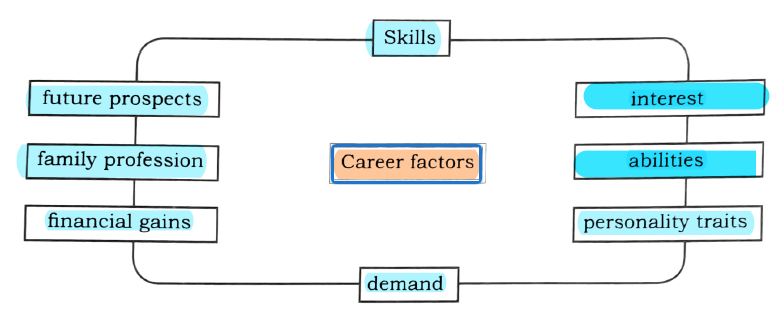
Important Career Factors
Choosing a career is a big decision and while choosing a career we have to give importance to some valuable points. Earlier it was the parents, teachers and other siblings who largely influenced our career choices but remember we should not just enter one area because our friends or siblings have picked it up. We should listen to our heart, understand what we are really interested in. See if we are good abilities to fulfil and then only look forward. Also considered the demand of your professionals, in the market, so your future will be secured. Without demand of particular education skill, you will not successes in your career.
Though you have good skills in particular profession but now it is outdated then you will not get success. For example if you have good skills in shorthand but now this course is not in demand as it replaced with computer technology, you will not get opportunity to show your skills. When your choose particular profession always see your personality abilities. Choosing a career can be daunting task. Sometime our family professions are in our blood so it is a good choice vise, versa it may be a bad choice too. Whatever the career you select it should gain profit and financial stability in future. You should assess your skills and interest, study the market and consult an experienced person before making a final decision and be secured.

Practice: Verbal to Non – Verbal ( Examples)

We use cookies to enhance our website for you. Proceed if you agree to this policy or learn more about it.
- Essay Database >
- Essays Samples >
- Essay Types >
- College Essay Example
Nonverbal Communication College Essays Samples For Students
46 samples of this type
Do you feel the need to examine some previously written College Essays on Nonverbal Communication before you start writing an own piece? In this open-access collection of Nonverbal Communication College Essay examples, you are granted a thrilling opportunity to examine meaningful topics, content structuring techniques, text flow, formatting styles, and other academically acclaimed writing practices. Exploiting them while composing your own Nonverbal Communication College Essay will definitely allow you to complete the piece faster.
Presenting high-quality samples isn't the only way our free essays service can aid students in their writing endeavors – our authors can also compose from scratch a fully customized College Essay on Nonverbal Communication that would make a genuine foundation for your own academic work.
Example Of Essay On Non-Verbal Communication: The Obama Case
Good paraphrasing refers to writing a statement or article in other words while still essay example, good essay about albert mehrabians communication model 1, albert mehrabian’s communication model.
Don't waste your time searching for a sample.
Get your essay done by professional writers!
Just from $10/page

Sample Essays On Nonverbal Communication
Essay on cross cultural communication, types of nonverbal communication essay sample.
There are different types of nonverbal communication techniques and processes used in daily communication. These include and not limited to the following; first, there is the facial expressions that form the highest proportion of nonverbal communication. Secondly is the use of gestures; involving the use of signs without words. Thirdly are the posture and the movement of the body. Fourth include the appearance, such as the color of clothes, hairstyles, etc. and lastly the use of haptic i.e. touching.
Cultural differences in nonverbal communication
Nonverbal functions essay examples, essay on nonverbal communication, example of nonverbal communication between different cultures essay.
Communication plays crucial role in life of each person. In order to communicate better, it is essential to acquire habits of nonverbal communication. A lot of people underestimate value on nonverbal communication. However, it is wrong and it should be understood that nonverbal communication holds the same position as verbal communication. Moreover, skills of nonverbal communication are acquired by people earlier than skills of verbal communication. From the early years children learn how to express their needs with gestures. Apart from this, nonverbal communication makes our speech lively and allows to express our feelings more clearly.
Short Answers Essay Sample
1. What was the name of the show that you watched? Was the nonverbal communication continuous? Describe specific examples of the channels of nonverbal communication (as discussed in your textbook) that you observed. Did you notice more when the sound was off? Why or why not?
Example Of Essay On Supporting Point 1
Essay plan & essay.
Part A. ESSAY PLAN Thesis Statement: No two people can see the world in exactly the same way because of differences in their status, gender, culture, traditions and environment where they were raised as shown through non-verbal communication. Non-verbal communication can create barriers between people and may elicit different interpretations and responses based on the people’s personal beliefs, status and expectations.
Good Example Of Communications In Security Settings Essay
Introduction, essay on cross cultural nonverbal differences.
Alton Barbour (1976) in his book, Louder Tan Words: Nonverbal Communication indicates that nonverbal communication adds up to 93% of any communication. This therefore shows that effective nonverbal Communication is very essential in communication. While nonverbal communication is very important, it worth noting that all communication including nonverbal communication takes place within cultural contexts. All meanings are learned and developed in the eyes of our different cultures. Cross cultural communication can be difficult in working context as different cultures have different meanings for different nonverbal cues.
Keywords: nonverbal, culture, differences.
Nonverbal Communication Essay
Free essay on diversity awareness.
Globalization has become an increasingly encompassing phenomenon in people’s lives today. Most significantly, globalization has bridged geographical spaces, so that in any context, there seem to be people from different backgrounds; people with different skills and experiences (Chuang, 2013). This is diversity. But it is not just about a situation that has come to be so that we have no choice but to deal with it. Rather, studies have showed that diversity has various benefits for individuals and ultimately the organization (discussed below).
Personal Growth
Inspiring essay about global contexts for learning.
(the author’s name) (the institutional affiliation)
Human Communication Essay
Human communication.
Communication skills are significant in conveying information correctly. Interpersonal communication occurs where an individual conveys information to another person. According to Floyd, it could be face-to-face communication, interviews or small group discussions (2009, p.78). Listening skills are vital for effective interpersonal communication. A communicator should understand the recipient and be interested in what the other person is saying. Maintaining eye contact and asking questions are positive signals to attract the recipient. The actions are important in order to be assertive and learn from the discussion at the end.
Example Of Exploring Negotiations/ Non-Verbal Communication Essay
Leadership communication essay example, meeting context summary, teamwork and interpersonal skills essay samples, smiles, winks, and words: essay you might want to emulate, cultural nonverbal communication research: example essay by an expert writer to follow, good example of cultures and customs: brazil essay.
Culture and customs influence the structure and functioning of organizations (Martin & Chaney, 2009). Brazil is one of the leading economic partners of the United States. Managing an organization in Brazil requires strategies attuned to the local culture and customs.
Background of Brazil
Expertly written essay on being a counselor to follow.
<Institution>
Free Essay On Negotiation
Communication analysis essay examples.
Communication has been an essential aspect in life of a human being. Since I began attending the communication classes in school, I have come to learn that communication is reaching to understanding others and been understood. Poor communication skills can destroy personal relationships. Both the verbal and nonverbal communication is part of my life even though some skills I have learnt them in school. The new skills in communication I learn in school have helped me reflect in my previous state of interaction and how insensitive I was towards others.
Free Essay About Professional Communication
Good essay on central to intercultural communication, essay on the effects of culture on communication, essay on language as a barrier to communication.
Communication and Problem Solving Skills
Communication and Problem Skills of Police Officers
Good essay on discussions, good despicable me part 2 movie assignment essay example, character identity, free essay about non-verbal communication codes.
<Student Name> <Name and Section # of course> <Instructor Name>
Non-Verbal Messages being sent in the Picture
Analyze two speeches essay, example of essay on analyze two speeches, sample essay on answers to evaluation questions.
Communication Style Evaluation
Communication as a tool enables people to solve problems through the sharing of ideas. The need to evaluate an effective communication style arises in situations where people understand the role of communication in identifying solutions to social situations or dilemmas. A communication style refers to the manner through which individuals plan the communication process. In additions, it refers to the manner, which people interact as they communicate. Communication styles dictate the effectiveness of communication and dialogue as a tool in problem solving.
Free Reflective Account Of A Critical Incident Which Occurred Whilst On The Clinical Essay Sample
Reflection on difficulty in communication, effective workplace communication essay examples, effective workplace communication, free essay on ethical behaviors in criminal justice, deception by the investigating officer in the investigative, interrogative, and testimonial processes, example of cultural difference essay, nonverbal rule assignment essay examples, example of target area one: daily productivity essay, personal background.
- Personal History Page 2 - Work History Page 2
- Summary of what I learned Page 3 - Benefits of further development Page 3 - Target Areas for Improvement Page 4
- Where am I? Page 4 - Where would I like to be? Page 4 - How will I accomplish my goals? Page 5 - Target Time-Line Page 5
Target Area Two: Face-to-Face Communication
- Where am I? Page 5 - Where would I like to be? Page 6 - How will I accomplish my goals? Page 6 - Target Time-LinePage 6
Target Area Three: Listening Skills
Example of outsourced: a study on culture and non-verbal cues essay, letter of advice essay sample, dear jim and jelka, essay on no strings attached communication breakdown, self-concept, relationship between communication language human being essay sample.
Password recovery email has been sent to [email protected]
Use your new password to log in
You are not register!
By clicking Register, you agree to our Terms of Service and that you have read our Privacy Policy .
Now you can download documents directly to your device!
Check your email! An email with your password has already been sent to you! Now you can download documents directly to your device.
or Use the QR code to Save this Paper to Your Phone
The sample is NOT original!
Short on a deadline?
Don't waste time. Get help with 11% off using code - GETWOWED
No, thanks! I'm fine with missing my deadline

Voice and Communication in Transgender and Gender Diverse Individuals pp 103–111 Cite as
Nonverbal Communication
- Ali Heitzman 5 ,
- Libby Lavella Perfitt 6 &
- Aaron Ziegler ORCID: orcid.org/0000-0001-6278-1701 7
- First Online: 19 July 2023
294 Accesses
Nonverbal communication is broadly defined as the way we exchange information or ideas using tools other than spoken language. In addition to nonverbal vocalizations like laughing, communicating nonverbally involves sensory modalities beyond hearing and includes facial expressions, eye gaze (oculesics), physical appearance, body movements (kinetics) and posture, use of space (proxemics) and time (chronemics), touch (haptics), smell (olfactory), artifacts, and environment. Nonverbal communication can be useful when expressing and affirming gender identity while also impacting gender perception. This chapter introduces aspects of nonverbal communication, explores existing research and gaps within this research, and describes the speech-language pathologist’s (SLP) role in supporting clients to identify and target nonverbal communication to promote affirming gender expression. A safe, compassionate, and discovery-based approach to training that honors all gender identities and recognizes people of all cultures and abilities is proposed. Supporting clients with nonverbal communication behaviors may involve addressing social competence skills in relevant scenarios and situations. By considering the client’s social competence skills, training of nonverbal behaviors is grounded in intentional communication acts throughout the process. Training for nonverbal communication can include metacognitive activities, creative movement, and role-play. The training approach introduced in this chapter allows clients the freedom to progress at their own pace, centers their preferences and goals in the most functional ways, and ultimately provides them with an empowering experience to draw from after discharge.
This is a preview of subscription content, log in via an institution .
Buying options
- Available as PDF
- Read on any device
- Instant download
- Own it forever
- Available as EPUB and PDF
- Durable hardcover edition
- Dispatched in 3 to 5 business days
- Free shipping worldwide - see info
Tax calculation will be finalised at checkout
Purchases are for personal use only
Purnell L. Cross cultural communication: verbal and non-verbal communication, interpretation and translation. In: Douglas M, Pacquiao D, Purnell L, editors. Global applications of culturally competent health care: guidelines for practice. Cham: Springer; 2018.
Google Scholar
Payrató L. Non-verbal communication. In: Verschueren J, Ostman JO, editors. Key notions for pragmatics. Amsterdam: John Benjamins Publishing Company; 2009.
Hardy TLD, Boliek CA, Aalto D, Lewicke J, Wells K, Rieger JM. Contributions of voice and nonverbal communication to perceived masculinity-femininity for cisgender and transgender communicators. J Speech Lang Hear Res. 2020;63(4):931–47. https://doi.org/10.1044/2019_JSLHR-19-00387 .
Article PubMed Google Scholar
Van Borsel J, De Cuypere G, Van den Berghe H. Physical appearance and voice in male-to-female transsexuals. J Voice. 2001;15(4):570–5. https://doi.org/10.1016/S0892-1997(01)00059-5 .
Van Borsel J, de Pot K, De Cuypere G. Voice and physical appearance in female-to-male transsexuals. J Voice. 2009;23(4):494–7.
American Speech-Language-Hearing Association. Scope of practice in speech-language pathology [Scope of Practice]. 2016. www.asha.org/policy/ .
Kring AM, Gordon AH. Sex differences in emotion: expression, experience, and physiology. J Pers Soc Psychol. 1998;74:686–703.
Article CAS PubMed Google Scholar
LaFrance M, Hecht MA, Levy Paluck E. The contingent smile: a meta-analysis of sex differences in smiling. Psychol Bull. 2003;129:305–34.
Coutrot A, Binetti N, Harrison C, Mareschal I, Johnston A. Gaze behavior provides a gender fingerprint. J Vision (Charlottesville Va.). 2016;16(12):71. https://doi.org/10.1167/16.12.71 .
Article Google Scholar
Hall JA. Nonverbal gender differences: communication accuracy and expressive style. Baltimore, MD: The Johns Hopkins University Press; 1984.
Book Google Scholar
Trevisan DA, Roberts N, Lin C, Birmingham E. How do adults and teens with self-declared autism spectrum disorder experience eye contact? A qualitative analysis of first-hand accounts. PLoS One. 2017;12(11):e0188446. https://doi.org/10.1371/journal.pone.0188446 .
Article CAS PubMed PubMed Central Google Scholar
Albas C. Proxemic behavior: a study of extrusion. J Psychol. 1991;131(5):697–702.
Ruggiero G, Rapuanol M, Cartaud A, Coello Y, Iachini T. Defensive functions provoke similar psychophysiological reactions in reaching and comfort spaces. Sci Rep. 2021;11:5170. https://doi.org/10.1038/s41598-021-83988-2 .
McCall C, Singer T. Facing off with unfair others: introducing proxemic imaging as an implicit measure of approach and avoidance during social interaction. PLoS One. 2015;10(2):e0117532. https://doi.org/10.1371/journal.pone.0117532 .
Høgh-Olesen H. Human spatial behaviour: the spacing of people, objects and animals in six cross-cultural samples. J Cogn Cult. 2008;8(2008):245–80. https://doi.org/10.1163/156853708X358173 .
Glass L. He says, she says: closing the communication gap between sexes. New York, NY: G.P. Putnam and Sons; 1992.
Nelson A, Golant SK. You don’t say: navigating nonverbal communication between the sexes. New York, NY: Prentice-Hall; 2004.
Hall JA. Gender and status patterns in social touch. In: Hertenstein M, editor. The handbook of touch: neuroscience, behavioral, and health perspectives. New York: Springer; 2011. p. 329–50.
Hirsch S, Boonin J. Nonverbal communication: assessment and training considerations across the gender and cultural spectrum. In: Adler R, Hirsch S, Pickering J, editors. Voice and communication therapy for the transgender/gender diverse client: a comprehensive clinical guide. 3rd ed. San Diego, CA: Plural Publishing; 2019. p. 249–80.
Helou LB, Gartner-Schmidt JL, Hapner ER, Schneider SL, Van Stan JH. Mapping meta-therapy in voice interventions onto the rehabilitation treatment specification system. Semin Speech Lang. 2021;42(01):5–18.
Article PubMed PubMed Central Google Scholar
Gilchrist JD, Solomon-Krakus S, Pila E, Crocker P, Sabiston CM. Associations between physical self-concept and anticipated guilt and shame: the moderating role of gender. Sex Roles. 2020;83:763–72. https://doi.org/10.1007/s11199-020-01137-x .
Worthington RL, Reynolds AL. Within-group differences in sexual orientation and identity. J Couns Psychol. 2009;56(1):44–55. https://doi.org/10.1037/a0013498 .
Lin C-S, Ku H-L, Chao H-T, Tu P-C, Li C-T, et al. Neural network of body representation differs between transsexuals and cissexuals. PLoS One. 2014;9(1):e85914. https://doi.org/10.1371/journal.pone.0085914 .
Download references
Author information
Authors and affiliations.
Outpatient, UCLA, Los Angeles, CA, USA
Ali Heitzman
Singuistics, Pinole, CA, USA
Libby Lavella Perfitt
Wellness Group for Voice, Speech, and Swallowing, LLC, Portland, OR, USA
Aaron Ziegler
You can also search for this author in PubMed Google Scholar
Corresponding author
Correspondence to Aaron Ziegler .
Editor information
Editors and affiliations.
Department of Otolaryngology/Head and Neck Surgery, Mount Sinai Health System, New York, NY, USA
Mark S. Courey
Department of Otolaryngology/Head and Neck Surgery, Georgetown University Hospital, Washington, D.C., DC, USA
Sarah K. Rapoport
Leanne Goldberg
SKB Voice Studio, New York, NY, USA
Sarah K. Brown
Rights and permissions
Reprints and permissions
Copyright information
© 2023 The Author(s), under exclusive license to Springer Nature Switzerland AG
About this chapter
Cite this chapter.
Heitzman, A., Lavella Perfitt, L., Ziegler, A. (2023). Nonverbal Communication. In: Courey, M.S., Rapoport, S.K., Goldberg, L., Brown, S.K. (eds) Voice and Communication in Transgender and Gender Diverse Individuals. Springer, Cham. https://doi.org/10.1007/978-3-031-24632-6_9
Download citation
DOI : https://doi.org/10.1007/978-3-031-24632-6_9
Published : 19 July 2023
Publisher Name : Springer, Cham
Print ISBN : 978-3-031-24631-9
Online ISBN : 978-3-031-24632-6
eBook Packages : Medicine Medicine (R0)
Share this chapter
Anyone you share the following link with will be able to read this content:
Sorry, a shareable link is not currently available for this article.
Provided by the Springer Nature SharedIt content-sharing initiative
- Publish with us
Policies and ethics
- Find a journal
- Track your research

Advertisement
Information transfer one, transfer of information.
Information can be of various types and may be presented in a wide variety of ways such as a paragraph or an or an essay, a graph, a table, a diagram, a picture, a sketch, etc. Transfer of information implies converting information from one form of presentation to another form. As such, information may be categorised into two broad areas:
Verbal : Here ideas are expressed using words, idioms and phrases in language.
Non-Verbal : In this area, information is represented by means of some graphic method either a diagram or sketch or or bar graph or even a flow chart.
Model Example 1
Observe the following bar diagram and write out two paragraphs about your interpretation of the same., fruit sales.

Solution:
The given bar graph represents the sale of fruits during a summer month in a supermarket in Dubai. The figures in ₹ thousands on the left on the Y-axis show the quantum of sales per month while the bars along the X-axis show the type of fruit, namely, apples, bananas, grapes, oranges and pears.
According to the bars plotted, the sale of bananas was the highest which almost touched ₹ 60,000 as against the sale of pears which was less than ₹ 30,000 only, almost half. Oranges occupied the second place with sales as high as ₹ 50,000. Apples fared well with a sale of ₹ 30,000. The consumption of fruits during the summer months seemed to be quite good.
Model Example 2
Transfer the information about the water-cycle given in the flow chart into a paragraph:.

Water-Cycle
It is common knowledge that the sun-rays absorb water from the surface of the Earth, namely seas, streams, rivers and other such water bodies. This gets converted into water vapour and thus rises. As it goes higher, it becomes cooler and begins to move. Various particles of vapour collect together and condense to form clouds which when become too heavy are difficult to sustain. The condensed vapour in these clouds then comes down in the form of rains and fills the various water bodies from where once again it evaporates with the heat of the sun and thus, the cycle of water is maintained.
Model Example 3
Read the following paragraph and transfer the information in the form of a tree diagram: .
We all read for a variety of reasons. Our basic reason for reading is probably pleasure. We read literature mostly because we enjoy it. Reading for pleasure may take various forms. We may read just to pass the time. We often read for information and knowledge. We find pleasure in learning about life in the Swiss Alps or the Mississippi river. We also read simply for enjoyment. We get pleasure from the arrangement of words. We can find pleasure even in syllables just as children like the sound 'Ring around the Rosie' although they may not know what the words mean.

Model Example 4
The following is the information given in the form of a table. write two paragraphs of about 70-80 words using the information given below., ans. about maharashtra and karnataka.
Maharashtra and Karnataka are neighbouring countries. Area wise Maharashtra is Larger than Karnataka. 3, 07, 713 sq. m. and 1, 91, 791 sq. km are the area of Maharashtra and Karnataka respectively. Mumbai is the Capital of former and Bangalore is for latter. Marathi is the main language spoken in Maharashtra whereas Kannada is for Karnataka. Godavari, Krishna, Bhima and Koyana are the main rivers running in Maharashtra. In Karnataka it is Tungabuadra, Kaveri. Jawar, Bajra and Sugarcane are the main crops in Maharashtra and Jawar, Tea and Rubber are the main crops in Karnataka. Mumbai, Nagpur, Aurangabad and Nasik are some of the major cities in Maharashtra. Mangalore, Hubli and Dharwad are the major cities in Karnataka.
A1. Information Transfer (Non-verbal to Verbal):
Transfer the given information into a paragraph.

Manufacture of Paper
Paper is chiefly used for writing. The raw material used in the manufacture of paper is wood, grass, bamboo and rags. There are several processes by which the raw material is converted into pulp. Most commonly the raw material is cut into pieces and then immersed in water to convert it into pulp. The pulp is then mixed with lime for whitening it. This pulp and lime mixture is boiled at high pressure. The pulp is next passed through wire meshes. The paper sheets are removed from the mesh while it is still wet. These wet sheets are passed over heated rollers to remove the water and the paper is dried so as to make thin sheets of paper.
A2. Read the following passage and complete the table
Dialect is a form of a language spoken in one area which may be different from other forms of the same language. Each language has dialects which change every few kilometers. India is a multi-lingual country. Each state follows its own language as its official language. For example, Marathi is the official language of Maharashtra, while Ahirani, Wharadi, Konkani and Malwani are its dialects. Several languages in India are spoken but do not have any script. In Karnataka, Kannada is the official language. Tulu is spoken in Karnataka but has no script. In England, English is the official language while Scottish, spoken in Scotland and Welsh spoken in Wales are dialects of English.
A 1. Transfer the information about the Water-cycle given in the flow chart into a paragraph:

Water-Cycle
It is common knowledge that the sunrays absorb water from the surface of the Earth — namely seas, streams, rivers and other such water bodies. This gets converted into water vapour and thus rises. As it goes higher, it becomes cooler and begins to move. Various particles ofvapour collect together and condense to form clouds which when become too heavy are difficult to sustain. The condensed vapour in these clouds then comes down in the form of rains and fills the various water bodies from where once again it evaporates with the heat of the Sun and thus, the cycle of water is maintained.

Information Transfer (Non-verbal to verbal)

Ans. THE JOURNEY OF MANUSCRIPT
From the given flow chart, it is very evident that the information pertains to the journey of a manuscript from its initial stage to the final printing of a book or a magazine.
Manuscripts are collected from both students and teachers. They are thoroughly screened and edited, where necessary additions, alterations and omissions are made to the copy. A rough draft is then prepared after which the manuscript is sent to the printer along with a dummy. Then comes the stage of proof correction. After the corrections are made and the manuscript is proofread, it is sent for final printing.
A2. Here are some tips about keeping healthy as given in a science magazine. Read and write in the form of Do’s and Don’ts (table):
You must include vegetables and fruits in your diet and drink a lot of water. You should avoid junk food and aerated water. You shouldn’t sit for long periods of time. Rather you should exercise regularly. You shouldn’t ignore the importance of good breathing habits. Try breathing deeply whenever you think of it. See to it that you sleep for at least 7 hours a day. In fact, you should avoid irregular timings.
PDF FILE TO YOUR EMAIL IMMEDIATELY PURCHASE NOTES & PAPER SOLUTION. @ Rs. 50/- each (GST extra)
Home — Essay Samples — Sociology — Nonverbal Communication — Nonverbal Communication: The Importance And Main Aspects
Nonverbal Communication: The Importance and Main Aspects
- Categories: Body Language Interpersonal Communication Nonverbal Communication
About this sample

Words: 183 |
Published: Nov 20, 2018
Words: 183 | Pages: 0 | 1 min read

Cite this Essay
Let us write you an essay from scratch
- 450+ experts on 30 subjects ready to help
- Custom essay delivered in as few as 3 hours
Get high-quality help

Verified writer
- Expert in: Sociology

+ 120 experts online
By clicking “Check Writers’ Offers”, you agree to our terms of service and privacy policy . We’ll occasionally send you promo and account related email
No need to pay just yet!
Related Essays
1 pages / 598 words
4 pages / 1801 words
3 pages / 1449 words
1 pages / 319 words
Remember! This is just a sample.
You can get your custom paper by one of our expert writers.
121 writers online
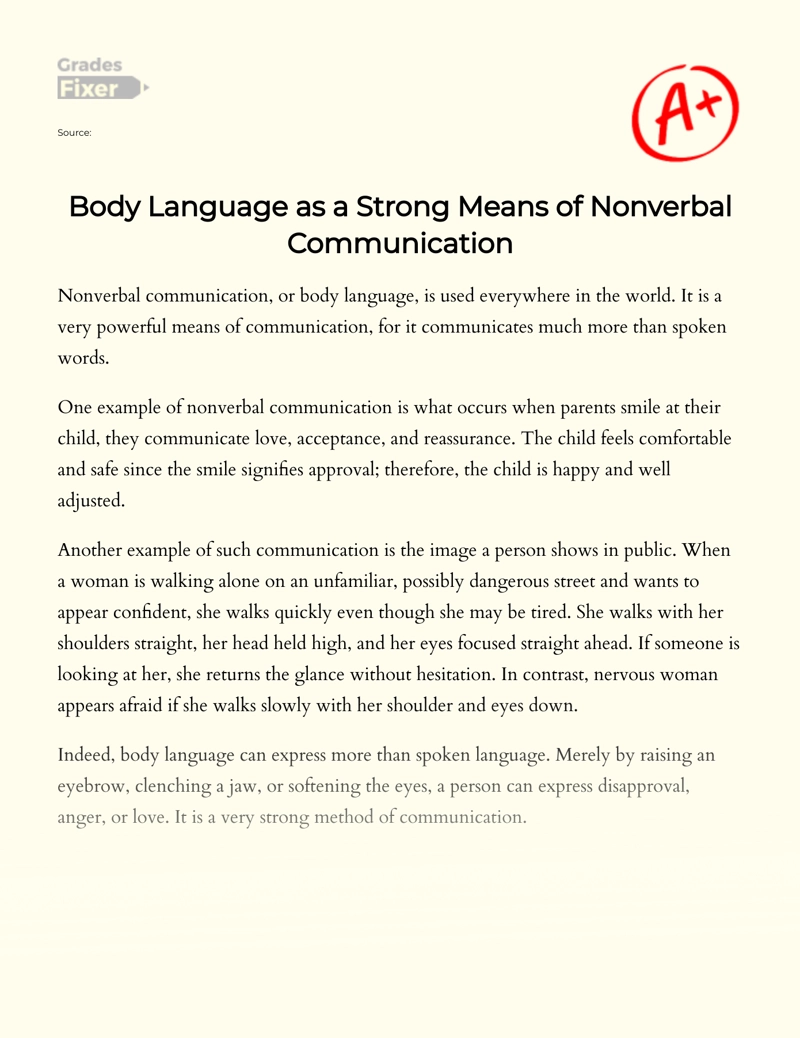
Still can’t find what you need?
Browse our vast selection of original essay samples, each expertly formatted and styled
Related Essays on Nonverbal Communication
Howe, N. (2018). How Sibling Imitation Affords Different Developmental Opportunities and Challenges. Journal of Child Psychology and Psychiatry, 59(9), 1032-1039.
Communication is not just about the words we speak; it also involves the use of nonverbal cues such as language. language plays a crucial role in conveying our thoughts, feelings, and intentions to others. In fact, research [...]
Sharing a glance with your partner from across the room can convey more than words ever could. Nonverbal communication plays a crucial role in forming and maintaining relationships by conveying emotions, intentions, and signals [...]
First impressions are a fundamental aspect of human interaction. We form these snap judgments within seconds of meeting someone, often based on appearance, body language, and initial conversations. These impressions can be [...]
Other than being categorized as formal or informal, communication can be classified as either verbal or non-verbal as well. Verbal or oral communication involves the use of speech to pass information. For verbal communication to [...]
Amy Cuddy presents “Power Posing” at a Ted conference in Edin, Scotland. She explains the importance of body language by how others may see them, but how they also see themselves. That by doing power poses can help them portray [...]
Related Topics
By clicking “Send”, you agree to our Terms of service and Privacy statement . We will occasionally send you account related emails.
Where do you want us to send this sample?
By clicking “Continue”, you agree to our terms of service and privacy policy.
Be careful. This essay is not unique
This essay was donated by a student and is likely to have been used and submitted before
Download this Sample
Free samples may contain mistakes and not unique parts
Sorry, we could not paraphrase this essay. Our professional writers can rewrite it and get you a unique paper.
Please check your inbox.
We can write you a custom essay that will follow your exact instructions and meet the deadlines. Let's fix your grades together!
Get Your Personalized Essay in 3 Hours or Less!
We use cookies to personalyze your web-site experience. By continuing we’ll assume you board with our cookie policy .
- Instructions Followed To The Letter
- Deadlines Met At Every Stage
- Unique And Plagiarism Free
Nonverbal Messages in Everyday Communications Essay
Nonverbal communication is the transmission of information that does not involve words and instead uses tactics such as body language, facial expressions, tonal shifts, or even silence. For example, smiling, maintaining eye contact, and presenting a pleasant smell can be categorized as nonverbally conveying your attractiveness and interest. Numerous principles govern the effective functioning of nonverbal communication (DeVito, 2016). Nonverbal messages are necessary for emotional expression and actively interact with the information contained in verbal ones by either complementing, contradicting, or substituting it. This principle is why impressions are largely formed by nonverbal messages such as posture and dress and can be craftily manipulated to exert influence and deceive. Furthermore, conversations are regulated and structured by nonverbal signals that you are ready to either speak or listen to. Finally, showing intimacy and communicating or confirming relationship status is mostly done nonverbally through gestures such as hand-holding.
In the article “The Naked Face”, Malcolm Gladwell explores how intuition might be the result of subconsciously but effectively detecting nonverbal communication. He discusses the first principle of nonverbal cues serving as crucial channels for revealing emotion, specifically facial expressions. Gladwell explains how two psychologists made an index of every possible facial muscular movement and cataloged which combinations communicated which specific emotion (Gladwell, 2002). Then, he delves into the second principle by explaining how involuntary facial microexpressions either confirm or contradict a person’s verbal messages by exposing their authentic feelings. With the help of such research, it is possible to perceive certain facts about the speaker’s identity and whether they are lying. Gladwell’s article illustrates that nonverbal communication is an essential aspect of interpersonal skills.
Every human being who participates in society and is present in a physical space with other people is utilizing nonverbal communication, whether consciously or not. It is not even necessary to verbally interact with others because your posture, facial expression, and clothes already divulge several things about your self-concept and social status. In my own everyday life, I choose to shower and wear clean clothes to communicate that I am a functioning, presentable adult to control impression formation. I smile and nod when listening to my friends or colleagues to display my interest in what they are saying and signal that it is my turn to listen. I look at the professor and take notes during class to communicate that I am paying attention and that this class is important to me. I add emojis to my texts to indicate whether I am joking or being serious. Everyday life involves countless interactions between verbal and nonverbal types of communication.
However, I have noticed that my nonverbal communication contradicts my verbal messages and needs improvement in certain instances. Sometimes, although I am interested in the content of a conversation, I often glance at my phone to check for notifications out of habit. I keep listening but automatically pull out my phone and start scrolling social media sites without fully processing what I am doing. Unfortunately, my actions and lack of eye contact communicate that I am bored, and my friends usually do not believe me if I insist that is not the case and feel disrespected. To combat this problem, in the future, I will keep my phone in my bag and commit my full attention to my friends.
Gladwell concludes that some people are better at “reading people’s thoughts just by looking at them” because of their superior nonverbal communication (Gladwell, 2002). They can analyze and detect certain facial tics or body language more quickly and effectively than others, either through intentional studying or years of subconscious experience (Gladwell, 2002). The potential benefits of this ability include better interpersonal communication in law enforcement, politics, and courtroom examination (DeVito, 2016). Gladwell cites numerous examples of psychologists recognizing that a government employee was lying or a random passerby was a dangerous criminal by analyzing nonverbal cues such as microexpressions. It could be leveraged to manipulate people and increase personal attraction and popularity in everyday life.
I believe Gladwell’s main “take-home message” about nonverbal communication is that it reveals hidden, involuntary information about the speaker and that acknowledging it is not always necessary in everyday life. Firstly, relaying information verbally requires conscious effort and indicates that we are ready to take accountability for our words; however, we cannot control our involuntary microexpressions. Confronting a person if their body language contradicts their verbal messages crosses certain boundaries and entails a specific obligation to respond. If my colleague looks miserable but tells me she is fine, it may be in my best interest to respect her privacy and pretend I believe her, so I do not have to get involved. Secondly, analyzing nonverbal cues is not an exact science and is mostly based on faith. While a psychologist may state that Philby’s reveal as a Soviet spy was predictable due to his microexpressions during court examination, his testimony could not have been used instead of hard evidence to judge him guilty. Nonverbal communication can be a useful tool but certain nuances must be taken into account.
DeVito, J. A. (2016). The interpersonal communication book (14th ed.). Pearson.
Gladwell, M. (2002). The naked face. Genius. Web.
- Chicago (A-D)
- Chicago (N-B)
IvyPanda. (2022, December 26). Nonverbal Messages in Everyday Communications. https://ivypanda.com/essays/nonverbal-messages-in-everyday-communications/
"Nonverbal Messages in Everyday Communications." IvyPanda , 26 Dec. 2022, ivypanda.com/essays/nonverbal-messages-in-everyday-communications/.
IvyPanda . (2022) 'Nonverbal Messages in Everyday Communications'. 26 December.
IvyPanda . 2022. "Nonverbal Messages in Everyday Communications." December 26, 2022. https://ivypanda.com/essays/nonverbal-messages-in-everyday-communications/.
1. IvyPanda . "Nonverbal Messages in Everyday Communications." December 26, 2022. https://ivypanda.com/essays/nonverbal-messages-in-everyday-communications/.
Bibliography
IvyPanda . "Nonverbal Messages in Everyday Communications." December 26, 2022. https://ivypanda.com/essays/nonverbal-messages-in-everyday-communications/.
- "The Order of Things" by Malcolm Gladwell
- “Outliers: The Story of Success” by Malcolm Gladwell
- Posture as a Non-Verbal Communication Element
- Malcolm Gladwell’s Book “Blink”
- "Outliers" by Malcolm Gladwell
- “A Tribute to the 100 Families” in Gladwell's Context Theory
- Jeff Bezos and Gladwell’s Success Principles
- "Outliers: The Story of Success" by Malcolm Gladwell
- Shaun Gladwell’s Art: Materials And Techniques
- “The Tipping Point” by Malcolm Gladwell
- Discussion of Conflict Capability
- Aspects of ‘Reading’ Others in Communication
- Impact of Conflict Resolution for Best Conversations
- Transformative Mediation: Conflict Management
- Communicating and Dealing with People You Can't Stand

IMAGES
VIDEO
COMMENTS
The information can be systematically transferred from Verbal to Non-verbal or Non-verbal to Verbal by using paragraphs, diagrams, graphs, maps, pictures etc. EXAMPLES: Non Verbal to Verbal. 1. Write a paragraph on "Rocks and Their Formations", with the help of following Table: Types of Rocks. Formed by.
Here you will learn how to transfer the given information in non-verbal form vis table. pie diagram, web diagram, flow chart and tree diagram etc. Q. 1. Given below is a paragraph outlining the uses of motorcycle. Transfer the information in the form of a web diagram or map.
Essays.io ️ Verbal and Nonverbal Communication, Essay Example from students accepted to Harvard, Stanford, and other elite schools ... that enables people to interact and transfer information either through verbal or nonverbal way. Verbal communication founds on the use of language, which is defined by prominent linguist Sapir as "purely ...
While verbal and nonverbal communications involve transferring and receiving information and are not connected to the brain, they are significantly different in such features as structure, miscommunication, continuousness, and distance and time. We will write a custom essay on your topic tailored to your instructions!
Writing skills. This video explain How to transfer non-verbal information to verbal with some simple steps. In this type, students have to transfer the infor...
5 + ESSAYS 5+ DIALOGUE WRITING 3+ EXPANSION OF IDEAS 10+ SPEECH WRITING 10+ LETTERS (FORMAL & INFORMAL) 5 ... Information Transfer (Non-verbal to verbal) Ans. THE JOURNEY OF MANUSCRIPT. From the given flow chart, it is very evident that the information pertains to the journey of a manuscript from its initial stage to the final printing of a ...
Read the following paragraph and transfer the information into the non-verbal form., , Literature comprises all that a person reads, sees or hears. Literature is composed of fiction and Non-fiction, categories. ... like a story, essays are short compositions by authors, biographies are write-ups on the life of others. by, another person, n ...
Adaptors can also be used in the non-verbal communication and they help one to adapt to the environment hence ensuring that the communicator is secure and comfortable. A good example would be the hairstyle or a behavior that is self adaptive. One may also use object-adaptors to convey a message of disinterest for instance.
The term requires an element of success in transmitting or imparting a message, whether information, ideas, or emotions. A communication therefore has three parts: the sender, the message, and the recipient. The sender 'encodes' the message, usually in a mixture of words and non-verbal communication. It is transmitted in some way (for ...
Nonverbal communication is often simply defined as communication without words. Others have noted that nonverbal communication includes "all behaviors that are not words" (Guerrero & Floyd, 2006, p. 4). Regardless of the deceiving simplicity of its definition, know that nonverbal communication is very complex.
Q.6. (A) Information Transfer: Al or A2. Do any ONE of the following: A1. Non-verbal to verbal: (5 marks) The following diagram shows important factors to be considered while choosing a career. Write a paragraph based on it. Give a suitable title to it.
Example Of Essay On Non-Verbal Communication: The Obama Case. ... Reiman (2007) defines communication as the process of information transfer from one character to another. Hence, nonverbal communication is a type in which wordless cues are sent and received between persons (Reiman, 2007). ... Non-verbal communication is sometimes also called ...
In this video we have covered English Writing skills topic "Information Transfer (verbal to Non-verbal and vice versa)" with solved examples and Hindi explan...
nonverbal communication, transfer of information from one person to another without the use of words or spoken language.Nonverbal communication can occur in a variety of ways, including through facial expressions, gestures, and body posture or position.. History. Studies on nonverbal communication became widespread in the 1960s, with extensive research categorizing nonverbal behaviours.
5 + ESSAYS 5+ DIALOGUE WRITING 3+ EXPANSION OF IDEAS 10+ SPEECH WRITING 10+ LETTERS (FORMAL & INFORMAL) 5 ... Information Transfer (Non-verbal to verbal) Ans. THE JOURNEY OF MANUSCRIPT. From the given flow chart, it is very evident that the information pertains to the journey of a manuscript from its initial stage to the final printing of a ...
Nonverbal communication is broadly defined as the way we exchange information or ideas using tools other than spoken language. In addition to nonverbal vocalizations like laughing, communicating nonverbally involves sensory modalities beyond hearing and includes facial expressions, eye gaze (oculesics), physical appearance, body movements (kinetics) and posture, use of space (proxemics) and ...
VERBAL TO NON-VERBAL | INFORMATION TRANSFER | ENGLISH WRITING SKILLS |In this video, you will see "INFORMATION TRANSFER - VERBAL TO NON- VERBAL" in English ...
Amy Lucas (2017), has also emphasised that both verbal and nonverbal are essential in developing relationships and strengthening positive forms of communication. In the video, several forms of nonverbal cues were displayed. However, four distinct nonverbal cues that will be discussed are attentiveness, eye contact, voice and gesture.
Information can be of various types and may be presented in a wide variety of ways such as a paragraph or an or an essay, a graph, a table, a diagram, a picture, a sketch, etc. Transfer of information implies converting information from one form of presentation to another form. ... Information Transfer (Non-verbal to Verbal): Transfer the given ...
There are three main aspects of nonverbal communication: facial expression, gestures, and tone of voice. Facial expression is the most universal form of language in the world. Therefore, in order to have a good first impression and grabbing audience's attention. It is because the similarity of facial expressions used to convey fear, anger ...
The outcomes of the observation relate to McCornack's definition of nonverbal communication, which he describes as "the intentional or unintentional transmission of meaning through an individual's nonspoken physical and behavioral cues" (211). Each member of the group tried to convey a message when using physical contact or vocals.
information transfer verbal to nonverbal essay
Nonverbal messages are necessary for emotional expression and actively interact with the information contained in verbal ones by either complementing, contradicting, or substituting it. This principle is why impressions are largely formed by nonverbal messages such as posture and dress and can be craftily manipulated to exert influence and deceive.